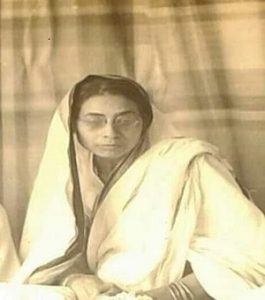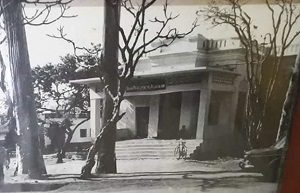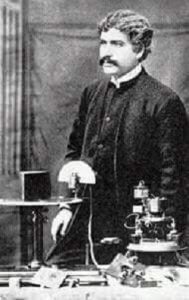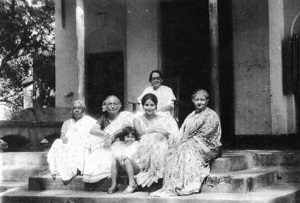Whenever I think of my Grandma, the first thing that comes to mind is how beautiful she was -slim, without an ounce of fat. Her long hair touched her knees. She had no time to look after herself. Her whole life was devoted to other’s well-being. She was not known to be a great social worker; we have never seen her felicitate any minister or ever gift a cheque to a governor for which her name would have appeared in a magazine. She could have done it all, if she wished to, for she had the opportunity. After all, she was the wife of a judge who was also the cousin of Sir Jagadish Bose. Renowned personalities of Brahmo Samaj1 used to regularly meet at her house Shantinibash in Giridih2.

I called my Grandma ‘Nima.’ I don’t know how this name came to stick. I spent lot of my childhood in Giridih with Grandma. People in Bihar call their grandmothers Nani while we in Bengal call them Didima. Nima seemed a combination of the two.
Writing about Nima fills my heart with happiness even now when I have reached the end of my life. Apparently, I had nothing in common with Nima. But in terms of my thinking and value system, I have tried to follow her footsteps. My Nima has been my role model. My memories of her are very sweet and endearing.

Nima, Madhurika Mitra, was one of fourteen children3. They were not too well off but were a religious family. They were initiated into Brahmoism. She was exceptionally beautiful-tall and slim. Long black tresses till knees, she had a melodious voice and could sing very well. The story goes that my grandfather, Amrit Nath Mitra wanted to marry her after hearing her sing. Amrit Nath Mitra was a successful and affluent Judge- extremely westernised in his ideas- in his attire and habits. He was twenty years older than Nima. On her wedding night, Nima hid herself in another room. She was all of sixteen and he was thirty-six4. The cause of her apprehension had been his dominating personality and his close-cropped beard. However, they were known to have had a happy married life. That must have been due to Nima’s talents-she was an expert homemaker, religious in nature, she spoke little and softly; it was her life’s mission to serve others; she was intelligent but never showed it off. She would have ensured everyone was happy and the ambience around her peaceful.

I don’t remember my grandfather – he died few after my birth. In 1942, my grandmother inherited the huge house in Giridih; I have heard that my grandfather also left behind plenty of money. Her sons and daughters were all well established by then. Nima could have enjoyed a lavish lifestyle as most of her contemporary ladies did. Influenced by Anglo-Indian culture, they played tennis, drank tea from fine china, gossiped in company and sometimes did charitable work, never forgetting to take photographs for publicity. This was not for Madhurika Mitra who hankered neither for name nor fame. She pledged to keep herself engaged by helping the poor and needy. Therefore, there aren’t any photograph or medals commemorating her commitment and hard work – not even a certificate. Even her own family members were not all aware of what she did.
I was fortunate to have I spent a lot of time with her and as I was very young, she saw no reason to keep anything away from me. She always said that one should never blow one’s trumpet while doing charity. Like Wordsworth’s “Violet by a mossy stone” she kept her activities away from public glare.
All my maternal uncles were very good looking, resembling Hollywood stars and the most handsome of them, was my second uncle Ajay Nath Mitra. I never met him. At the time of my birth, my uncle was in a sanatorium, struck down by consumption. When he heard of my birth, he sent a telegram “Welcome Supriya.” To pay homage to his memory, my name remained.
Sometime later, breaking his mother’s heart, Ajay Nath died. I heard following this tragedy, Nima took to sleeping on a mat on the terrace of her house, stopped taking care of her hair and practically gave up eating. However, I never heard her lamenting. She kept the sorrow of losing a son buried deep inside her.
Nima was incredibly disciplined. She started her day at dawn, plucking different varieties of white jasmine and tuberose and placed them in front of my grandfather and uncle’s photographs; she would sing a few Brahmo songs and also read passages from Ram Mohan Roy and Shibnath Sastri’s writings5. Needless to say, this ritual she followed in private. I used to sleep in my grandmother’s room and therefore was fortunate to see and hear her. She then used to sit at her writing desk and write several letters. She never forgot to wish people on their birthdays and wedding anniversaries in a postcard or in an envelope; or she would simply write to inquire after their welfare. Every day the peon came to deliver and collect letters.
Nima’s was a huge house with a large garden that had different fruit trees – mangoes, blackberries, custard apples, sapodilla plums. At the back were tall trees- shaal, mohua and eucalyptus. On two sides of the property were two out houses for security guards in my grandfather’s time.
But now, two families lived. They were educated but rather poor. Every day, Nima sent them food. They had a very strong sense of self-respect and refused charity from others – but how could they refuse help from a person like Nima? I don’t think Nima took rent from them.
Kamaladidi lived with Nima and took care of her and we extended her due respect. Gura was the watchman. There used to be a car in the garage. One day we found that the car had been sold and a cycle rickshaw took its place. Gura became its driver. Most of the time we traveled by horse cart (tanga) or on a cycle rickshaw.
And from morning, our garden used to fill up with policemen from the prison which was opposite the house. The court was a little way down the road. The water from the well in the garden was known to be very tasty which is what the policemen came to drink. Perhaps that was the reason we never heard of any incident of theft in that house. The name of the house was Shantinibash(abode of peace) and peace (shanti) indeed reigned.
Nima became busy from early morning with her household chores. She began by chopping vegetables to perfection. I learnt all the different ways in which potatoes could be cut for different kinds of curries. Initially I was very surprised because Nima was a small eater and at supper, she had milk, puffed rice and batasha6. But food was cooked to serve the poor and to maintain good relations with neighbours. Kamaladidi was an excellent cook, specially of vegetarian dishes. The next step was to pour the cooked dishes meticulously in brass or copper bowls. This was Kamaladidi’s duty. Gura and I then went distributing them among the neighbours. An unprecedented pleasure used to fill my heart.
There was no demarcation between poor and rich families. There were many affluent people living in Giridih at that time, including statistician Prashanta Mahalanabis7, artist Binode Bihari Mukherjee8 among others. Everyday many beggars came to the house. In Nima’s store- room, a large sack of rice (cleaned and without any stone chips) was set aside. Every beggar got a bowl of rice, batasha and a glass of water. I used to wait for the arrival of the beggars. In giving alms, Nima flaunted no pride; she appeared to have felt honoured at the opportunity of helping them.
I cannot recall Nima resting in the afternoon or taking a nap. There was so much to do – pickles, bori (small balls of pulses and dried) and mango papad. Making mango papad was quite an affair- even I had to bathe early on the day they were to be made. First the mango juice had to be extracted and boiled and then poured into beautiful engraved stone plates to be dried under the sun. The hardest bit was to keep a watch over them, that I did, like a good girl. However, all these were made to be given away to others.
There was no electricity at home even in early 1950s. In the afternoon, we cleaned the lanterns and poured kerosene oil. After sun-down, there was quite an eerie atmosphere and I never dared go out to the garden. Later when we did have electricity we missed the ghostly dusk – half- darkness and half -light gave us quite a thrill.
In the evening many guests dropped by to meet Nima – to inquire after her well-being or to seek advice. To me, Nima appeared like an empress. A guest would, on some occasions, break into a song and Nima joined in. There was never any gossip or criticism of people. Nobody dared to do that in her presence. I couldn’t sing but Nima never regretted that. She was not in the habit of finding faults in others.
The house was full of books—- hard bounded magazines like Mouchak, Sishusathi, Probasi9—-I used to sit on the branch of a mango tree and read Mouchak and Sisusathi. Nima read Probasi. My love for reading literature began here. There was a different rhythm to life in the most peaceful and blissful environment. On Sundays, Nima and I used to visit the Brahmo Samaj. She would decorate the podium with flowers and sing songs.

Well known scientist Sir Jagadish Chandra Bose was my grandad’s first cousin (son of his paternal aunt). Both enjoyed a close relationship. Jagadish Bose was very fond of coming and staying in Giridih’s Shantibash. He died in the house. I remember the room; nobody used it after his death. I was born in the room, adjoining it. This was the time when from fear of Japanese bombing, my mother came to stay in Giridih. I saw the light of life in the hands of a Bihari midwife. My time of birth was in the morning at 10 o’clock when people were busy rushing to work in the court.
Lady Abala Bose and Sir Jagadish Chandra Bose often said that every girl should seek training under Nima on how to run a household. I am told that the world- renowned scientist shared the same table with her very poor relatives for meals. Sir Jagadish Bose loved to see Nima feeding the poorest of the poor. He made special trips to Giridih to watch Nima’s ‘kangal bhojon10.’ She served the people with a lot of care, khichdi, fries, chutney and sweets, on shaal leaves in the open field next to the well against the beautiful backdrop of eucalyptus trees. Word would get around and men and women gathered in large numbers.
I have always seen Nima wearing white cotton saris. For winter, she may have possessed a couple of white silks. She followed strictly the rules expected of a Hindu widow, including fasting on certain days11. Nima had a separate kitchen and store-room where onions and garlic were not permitted. When I grew up, I often thought about the fact that Brahmo widows did not have to follow such an austere regimen. It was Nima’s self-imposed discipline to imitate the lifestyle of ancient sages. Even when immersed in daily life’s trivialities, she kept herself away. She ate from a white marble plate and before starting to eat, she would set aside a little portion of her food in memory of her husband and son. This she did very discreetly. Since I was a little girl, I was privy to these rituals . The manner in which she bore her hardship left an indelible mark on me.
When she visited Kolkata she always stayed in her eldest son’s house, never with her daughters. She put her daughter in law, Chitra Mitra(Boromami) on a high pedestal; my elder aunt reciprocated her affection with deep respect. They were truly soul mates.
Nothing gave Nima more pleasure than charity. She would regularly find out if any of her neighbours and close and distant relatives needed anything, either by visiting them or writing to them. I accompanied Nima when she went to look upon some very distressed families. Some of them were too proud to take help from others but could never refuse Nima and accepted her help with gratitude.
In Calcutta, she used to collect used clothes, and even shoes; asking for used things never embarrassed her. From us, she asked for old books and exercise books with empty sheets that she would tear and bind separately to distribute.
While travelling to Calcutta by train, a coupe had to be booked for Nima and Kamaladidi. For her needs, she had a small case to carry a few saris; the suitcase and large pouch were filled with things to give away. She always said that the poor among middle class find it hard to ask for help. I wonder if people in the 1950s knew about grassroots and recycling but Nima did and put her awareness to good purpose. Those who came for help, did so with their head held high because they always brought little gifts like sweets and pickles for Nima, never empty handed. People came to one another’s help, in crisis stood by them; this was customary.
In 1963, after getting married, I started my life in a beautiful bungalow in Titagarh along the Ganges. When she came to visit me, she brought dry food, fearing that I may have forgotten her strict rules, married as I was into an anglicised family. I hadn’t forgotten any. To her surprise, I bathed and cooked her meal in a separate pot and then served her in her white marble plate that she had presented me with. She was speechless when she found out that I had not overlooked the minutest of details. She never ate in front of others so I served her food in a separate room and won her commendation as a good housewife. These are my sweet and beautiful memories.

My youngest maternal uncle (Chhotomama) married a divorcee and that raised quite a storm in the family, with people crying and being very dramatic. Disregarding all oppositions, he married the girl he fell in love with. Nobody was there to welcome the new bride but my Nima blessed her new daughter-in-law following the custom and always accorded her the respect she deserved.

With age, her health started failing. She left her Giridih home and came to stay with my elder uncle. Boromami made a separate kitchen and storeroom. Nima did something extraordinary – she gave away all her belongings – pieces of furniture to some, utensils to others. She rid herself of all material belongings. When we went to see her, she gave us lozenges in the absence of home-made sweetmeats.
Memories play tricks with us. I don’t wish to remember Nima being frail and dependent. In my mind the image is of Nima in Giridih, busy from morning till night serving and helping the poor. All white-her complexion, her clothes, her white marble plate, white flowers to worship god with, and overriding all, her unblemished, pure white heart.
Supriya Roy retired as a teacher and continues to be an avid reader. She is now a freelance writer and lives in Kolkata.
Footnotes
- A 19th century religious movement started in Bengal to reform superstitions, prejudices and corrupt practices within Hinduism
- A hill station in the province of Jharkhand in eastern India, it used to be in Bihar and popular with Bengalis as a get away from Calcutta
- She was born sometime around 1888 and 1890
- They married in the first decade of the 20th century-1904 or 1906
- Rammohan Roy was the founder of Brahmo movement and Shibnath Sastri, an important ideologue
- sweet made from sugar or jaggery juice
- Leading Indian Statistician. The Institute of Statistical Research was based in Giridih
- Well known artist of Bengal
- Journals published in Bengali
- Feeding the poor
- Traditionally Hindu widows were expected to give up normal living and lead a life of austerity on a strict vegetarian diet

A lovely read of a time that has vanished. The lives that Nima and people of her generation and social background lived is like a fairy story now. Madam, I may have met you- do you live in New alipore? I was privileged to hear your impressions about the recently passed away father of a friend of mine- Sreemati Mukherjee. Lovely to hear of your memories. Do share some more.
A wonderful story. Another proof of how close we could be to great individuals. Sir J C Bose was one of the greatest scientists the world has seen.
Another beautiful story